Law for Business Managers: Analysis of Contract, Tort, Corporation
VerifiedAdded on 2023/01/06
|11
|3656
|85
Report
AI Summary
This report provides a detailed analysis of several key areas within business law. It begins by differentiating between representation and terms of a contract, illustrating the concepts with a case scenario involving a car purchase and the application of the rules of relative expertise. The report then explores the tort of negligence, outlining the essential elements required to establish a successful claim, including duty of care, breach of duty, and causation of harm. It discusses the significance of 'Res Ipsa Loquitur' in negligence cases. Finally, the report examines the concept of a corporation as a legal entity or artificial person, touching on the ownership, management, and control of a corporation. The report draws on relevant case law and legal principles to illustrate the concepts discussed.
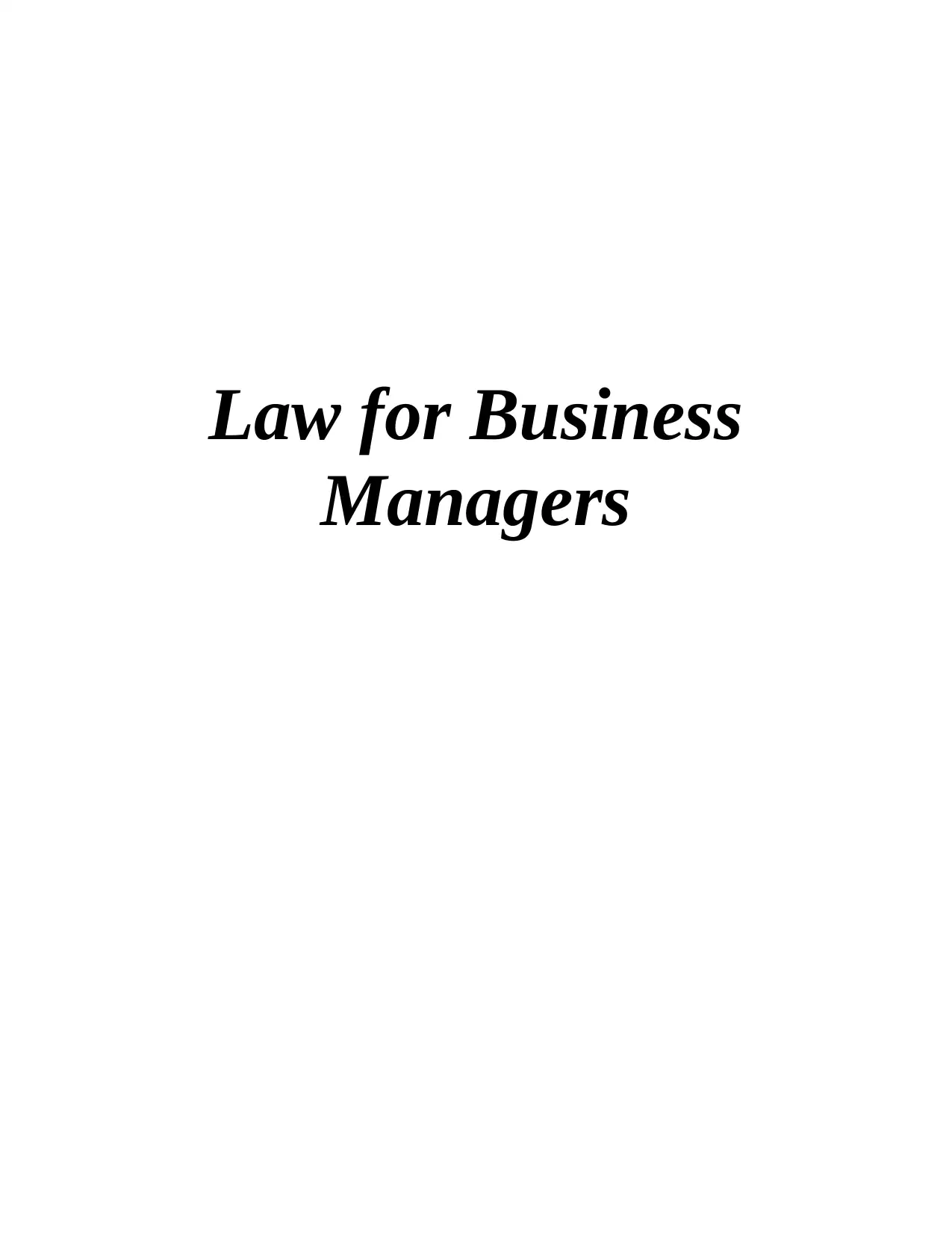
Law for Business
Managers
Managers
Paraphrase This Document
Need a fresh take? Get an instant paraphrase of this document with our AI Paraphraser
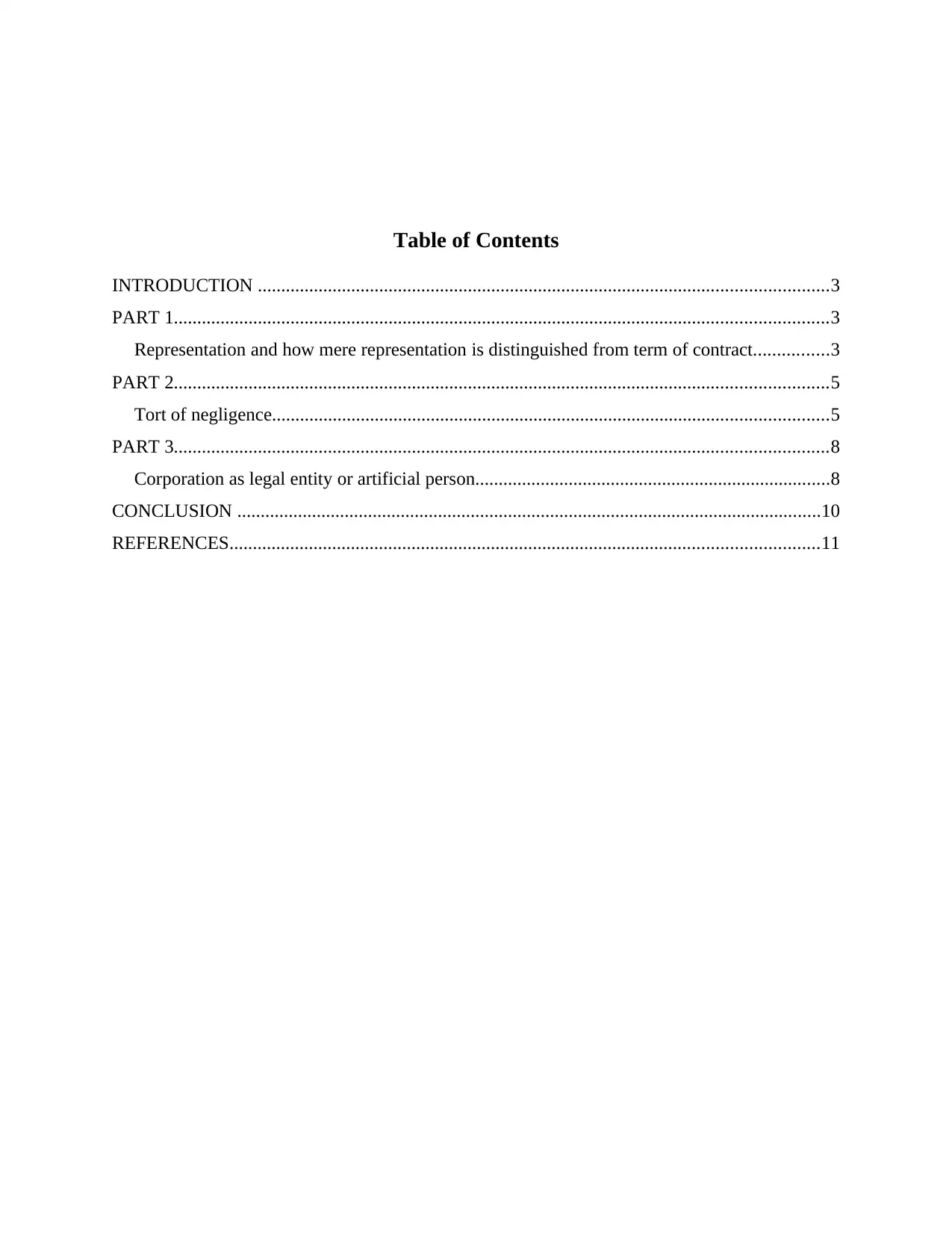
Table of Contents
INTRODUCTION ..........................................................................................................................3
PART 1............................................................................................................................................3
Representation and how mere representation is distinguished from term of contract................3
PART 2............................................................................................................................................5
Tort of negligence.......................................................................................................................5
PART 3............................................................................................................................................8
Corporation as legal entity or artificial person............................................................................8
CONCLUSION .............................................................................................................................10
REFERENCES..............................................................................................................................11
INTRODUCTION ..........................................................................................................................3
PART 1............................................................................................................................................3
Representation and how mere representation is distinguished from term of contract................3
PART 2............................................................................................................................................5
Tort of negligence.......................................................................................................................5
PART 3............................................................................................................................................8
Corporation as legal entity or artificial person............................................................................8
CONCLUSION .............................................................................................................................10
REFERENCES..............................................................................................................................11
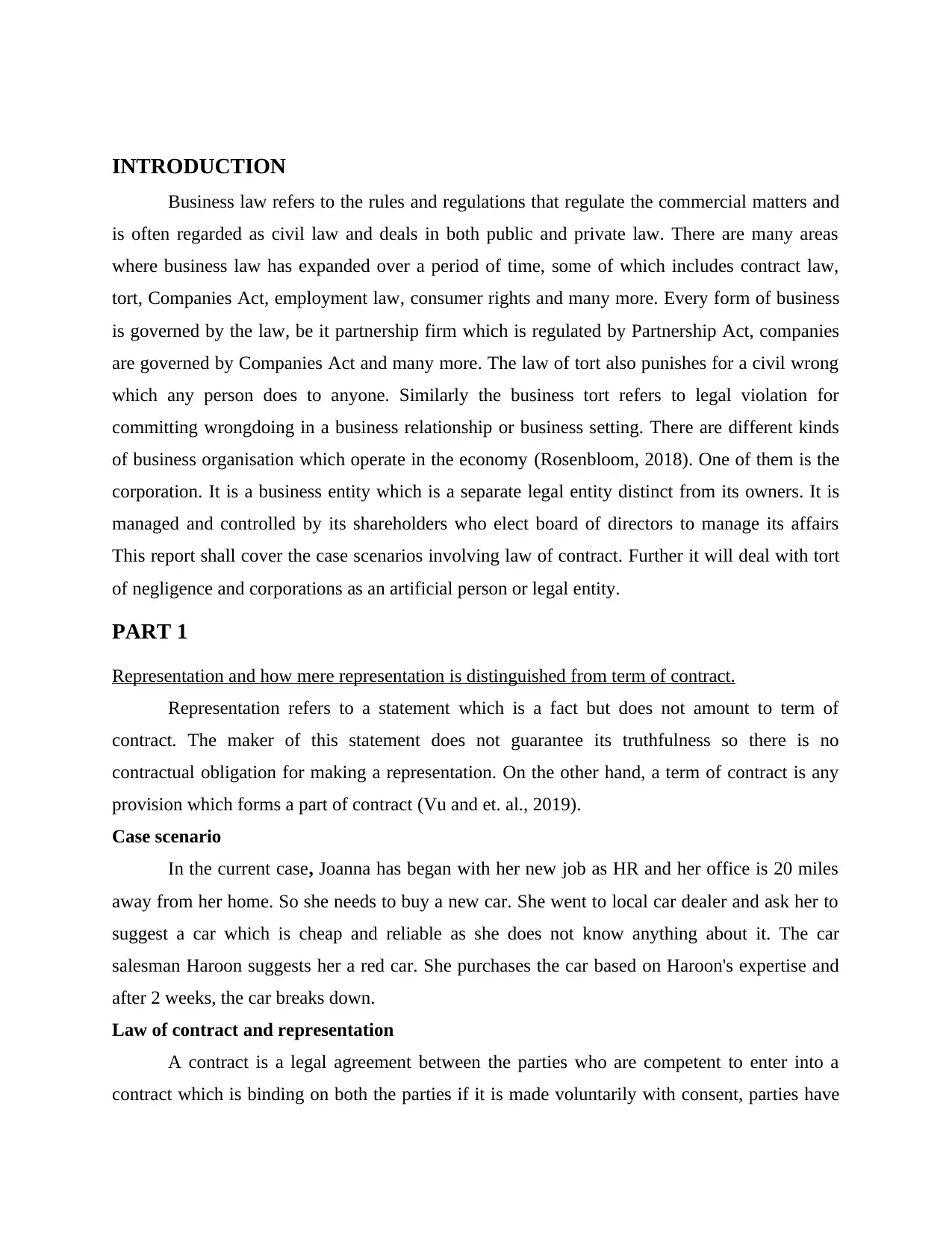
INTRODUCTION
Business law refers to the rules and regulations that regulate the commercial matters and
is often regarded as civil law and deals in both public and private law. There are many areas
where business law has expanded over a period of time, some of which includes contract law,
tort, Companies Act, employment law, consumer rights and many more. Every form of business
is governed by the law, be it partnership firm which is regulated by Partnership Act, companies
are governed by Companies Act and many more. The law of tort also punishes for a civil wrong
which any person does to anyone. Similarly the business tort refers to legal violation for
committing wrongdoing in a business relationship or business setting. There are different kinds
of business organisation which operate in the economy (Rosenbloom, 2018). One of them is the
corporation. It is a business entity which is a separate legal entity distinct from its owners. It is
managed and controlled by its shareholders who elect board of directors to manage its affairs
This report shall cover the case scenarios involving law of contract. Further it will deal with tort
of negligence and corporations as an artificial person or legal entity.
PART 1
Representation and how mere representation is distinguished from term of contract.
Representation refers to a statement which is a fact but does not amount to term of
contract. The maker of this statement does not guarantee its truthfulness so there is no
contractual obligation for making a representation. On the other hand, a term of contract is any
provision which forms a part of contract (Vu and et. al., 2019).
Case scenario
In the current case, Joanna has began with her new job as HR and her office is 20 miles
away from her home. So she needs to buy a new car. She went to local car dealer and ask her to
suggest a car which is cheap and reliable as she does not know anything about it. The car
salesman Haroon suggests her a red car. She purchases the car based on Haroon's expertise and
after 2 weeks, the car breaks down.
Law of contract and representation
A contract is a legal agreement between the parties who are competent to enter into a
contract which is binding on both the parties if it is made voluntarily with consent, parties have
Business law refers to the rules and regulations that regulate the commercial matters and
is often regarded as civil law and deals in both public and private law. There are many areas
where business law has expanded over a period of time, some of which includes contract law,
tort, Companies Act, employment law, consumer rights and many more. Every form of business
is governed by the law, be it partnership firm which is regulated by Partnership Act, companies
are governed by Companies Act and many more. The law of tort also punishes for a civil wrong
which any person does to anyone. Similarly the business tort refers to legal violation for
committing wrongdoing in a business relationship or business setting. There are different kinds
of business organisation which operate in the economy (Rosenbloom, 2018). One of them is the
corporation. It is a business entity which is a separate legal entity distinct from its owners. It is
managed and controlled by its shareholders who elect board of directors to manage its affairs
This report shall cover the case scenarios involving law of contract. Further it will deal with tort
of negligence and corporations as an artificial person or legal entity.
PART 1
Representation and how mere representation is distinguished from term of contract.
Representation refers to a statement which is a fact but does not amount to term of
contract. The maker of this statement does not guarantee its truthfulness so there is no
contractual obligation for making a representation. On the other hand, a term of contract is any
provision which forms a part of contract (Vu and et. al., 2019).
Case scenario
In the current case, Joanna has began with her new job as HR and her office is 20 miles
away from her home. So she needs to buy a new car. She went to local car dealer and ask her to
suggest a car which is cheap and reliable as she does not know anything about it. The car
salesman Haroon suggests her a red car. She purchases the car based on Haroon's expertise and
after 2 weeks, the car breaks down.
Law of contract and representation
A contract is a legal agreement between the parties who are competent to enter into a
contract which is binding on both the parties if it is made voluntarily with consent, parties have
⊘ This is a preview!⊘
Do you want full access?
Subscribe today to unlock all pages.

Trusted by 1+ million students worldwide
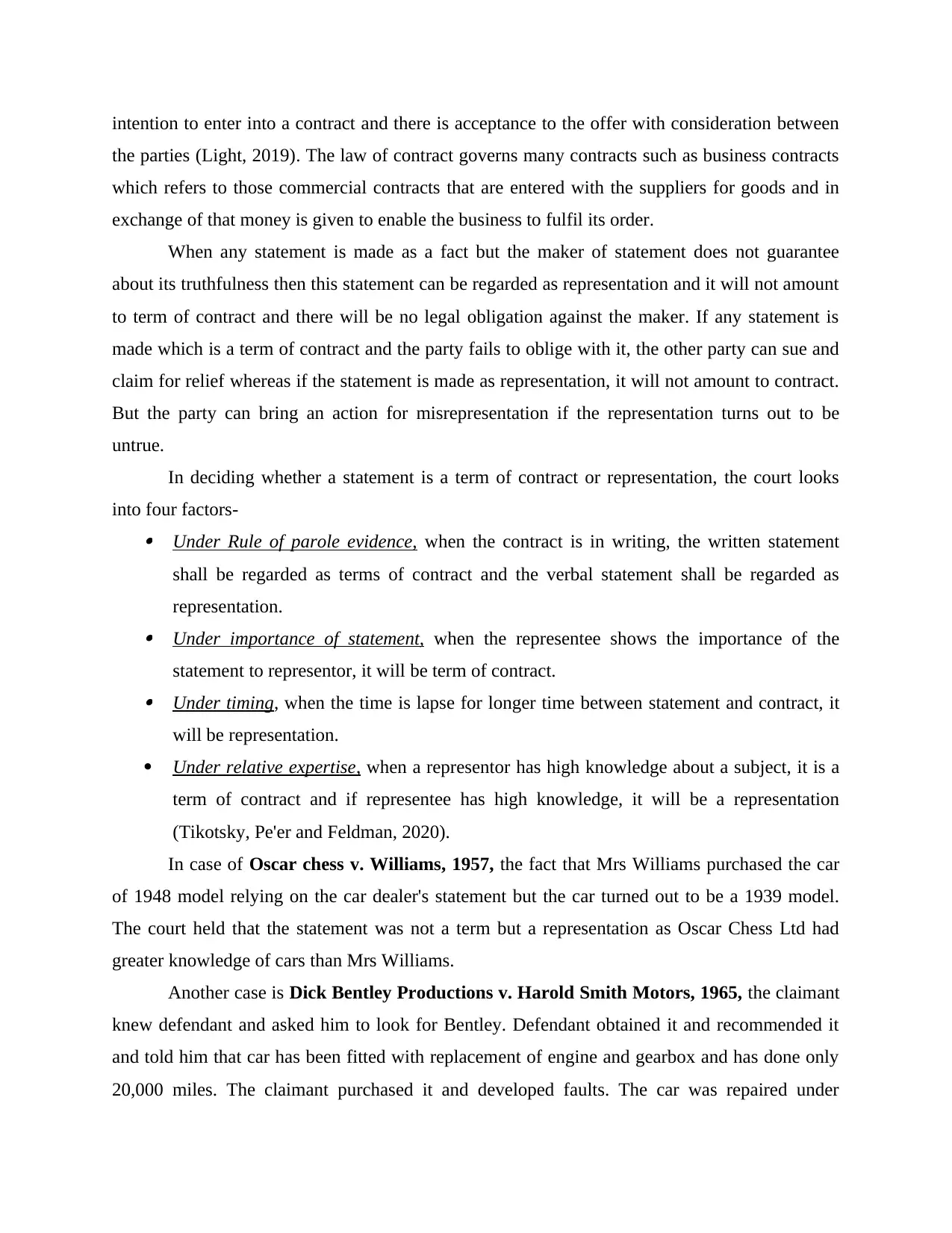
intention to enter into a contract and there is acceptance to the offer with consideration between
the parties (Light, 2019). The law of contract governs many contracts such as business contracts
which refers to those commercial contracts that are entered with the suppliers for goods and in
exchange of that money is given to enable the business to fulfil its order.
When any statement is made as a fact but the maker of statement does not guarantee
about its truthfulness then this statement can be regarded as representation and it will not amount
to term of contract and there will be no legal obligation against the maker. If any statement is
made which is a term of contract and the party fails to oblige with it, the other party can sue and
claim for relief whereas if the statement is made as representation, it will not amount to contract.
But the party can bring an action for misrepresentation if the representation turns out to be
untrue.
In deciding whether a statement is a term of contract or representation, the court looks
into four factors- Under Rule of parole evidence, when the contract is in writing, the written statement
shall be regarded as terms of contract and the verbal statement shall be regarded as
representation. Under importance of statement, when the representee shows the importance of the
statement to representor, it will be term of contract. Under timing, when the time is lapse for longer time between statement and contract, it
will be representation.
Under relative expertise, when a representor has high knowledge about a subject, it is a
term of contract and if representee has high knowledge, it will be a representation
(Tikotsky, Pe'er and Feldman, 2020).
In case of Oscar chess v. Williams, 1957, the fact that Mrs Williams purchased the car
of 1948 model relying on the car dealer's statement but the car turned out to be a 1939 model.
The court held that the statement was not a term but a representation as Oscar Chess Ltd had
greater knowledge of cars than Mrs Williams.
Another case is Dick Bentley Productions v. Harold Smith Motors, 1965, the claimant
knew defendant and asked him to look for Bentley. Defendant obtained it and recommended it
and told him that car has been fitted with replacement of engine and gearbox and has done only
20,000 miles. The claimant purchased it and developed faults. The car was repaired under
the parties (Light, 2019). The law of contract governs many contracts such as business contracts
which refers to those commercial contracts that are entered with the suppliers for goods and in
exchange of that money is given to enable the business to fulfil its order.
When any statement is made as a fact but the maker of statement does not guarantee
about its truthfulness then this statement can be regarded as representation and it will not amount
to term of contract and there will be no legal obligation against the maker. If any statement is
made which is a term of contract and the party fails to oblige with it, the other party can sue and
claim for relief whereas if the statement is made as representation, it will not amount to contract.
But the party can bring an action for misrepresentation if the representation turns out to be
untrue.
In deciding whether a statement is a term of contract or representation, the court looks
into four factors- Under Rule of parole evidence, when the contract is in writing, the written statement
shall be regarded as terms of contract and the verbal statement shall be regarded as
representation. Under importance of statement, when the representee shows the importance of the
statement to representor, it will be term of contract. Under timing, when the time is lapse for longer time between statement and contract, it
will be representation.
Under relative expertise, when a representor has high knowledge about a subject, it is a
term of contract and if representee has high knowledge, it will be a representation
(Tikotsky, Pe'er and Feldman, 2020).
In case of Oscar chess v. Williams, 1957, the fact that Mrs Williams purchased the car
of 1948 model relying on the car dealer's statement but the car turned out to be a 1939 model.
The court held that the statement was not a term but a representation as Oscar Chess Ltd had
greater knowledge of cars than Mrs Williams.
Another case is Dick Bentley Productions v. Harold Smith Motors, 1965, the claimant
knew defendant and asked him to look for Bentley. Defendant obtained it and recommended it
and told him that car has been fitted with replacement of engine and gearbox and has done only
20,000 miles. The claimant purchased it and developed faults. The car was repaired under
Paraphrase This Document
Need a fresh take? Get an instant paraphrase of this document with our AI Paraphraser
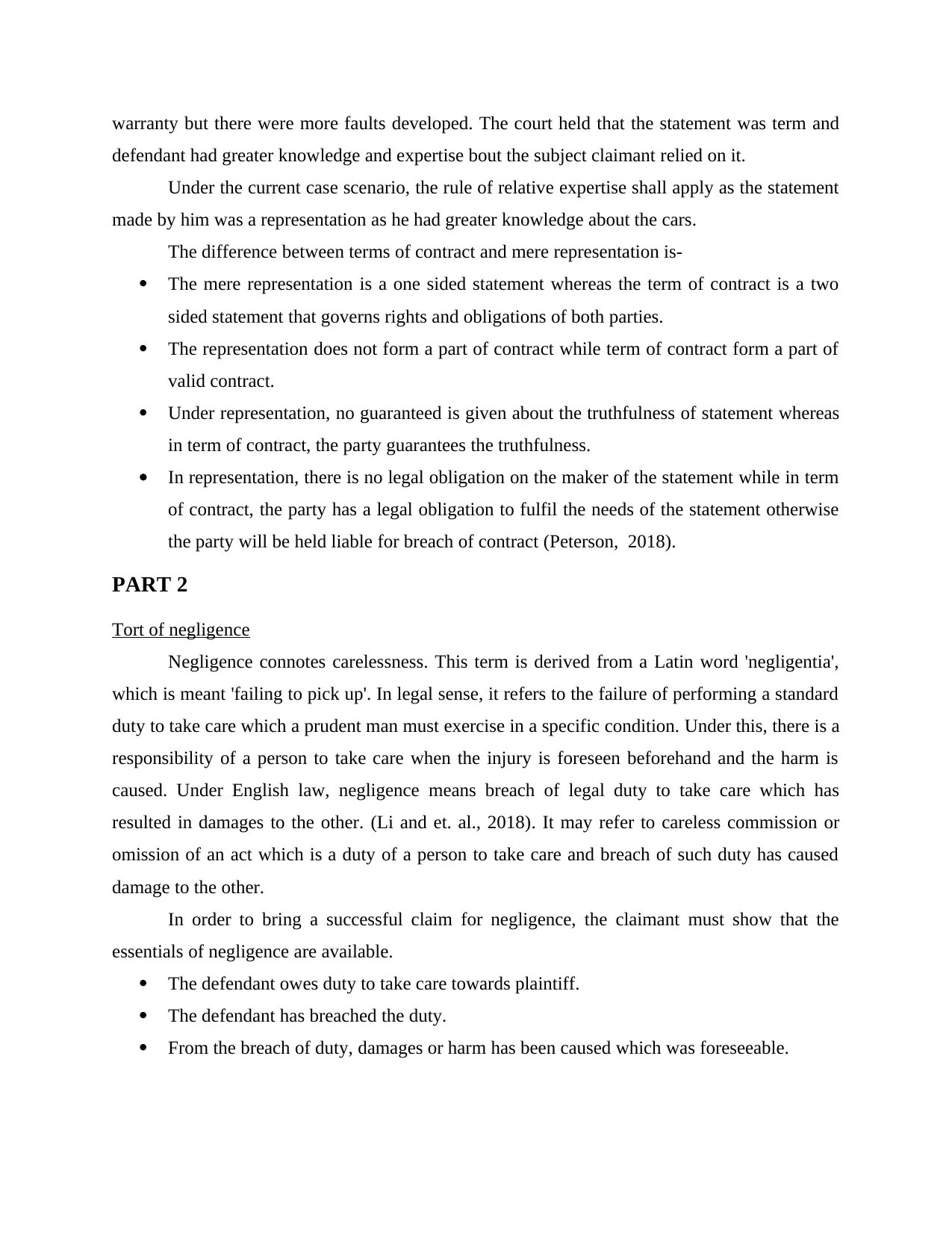
warranty but there were more faults developed. The court held that the statement was term and
defendant had greater knowledge and expertise bout the subject claimant relied on it.
Under the current case scenario, the rule of relative expertise shall apply as the statement
made by him was a representation as he had greater knowledge about the cars.
The difference between terms of contract and mere representation is-
The mere representation is a one sided statement whereas the term of contract is a two
sided statement that governs rights and obligations of both parties.
The representation does not form a part of contract while term of contract form a part of
valid contract.
Under representation, no guaranteed is given about the truthfulness of statement whereas
in term of contract, the party guarantees the truthfulness.
In representation, there is no legal obligation on the maker of the statement while in term
of contract, the party has a legal obligation to fulfil the needs of the statement otherwise
the party will be held liable for breach of contract (Peterson, 2018).
PART 2
Tort of negligence
Negligence connotes carelessness. This term is derived from a Latin word 'negligentia',
which is meant 'failing to pick up'. In legal sense, it refers to the failure of performing a standard
duty to take care which a prudent man must exercise in a specific condition. Under this, there is a
responsibility of a person to take care when the injury is foreseen beforehand and the harm is
caused. Under English law, negligence means breach of legal duty to take care which has
resulted in damages to the other. (Li and et. al., 2018). It may refer to careless commission or
omission of an act which is a duty of a person to take care and breach of such duty has caused
damage to the other.
In order to bring a successful claim for negligence, the claimant must show that the
essentials of negligence are available.
The defendant owes duty to take care towards plaintiff.
The defendant has breached the duty.
From the breach of duty, damages or harm has been caused which was foreseeable.
defendant had greater knowledge and expertise bout the subject claimant relied on it.
Under the current case scenario, the rule of relative expertise shall apply as the statement
made by him was a representation as he had greater knowledge about the cars.
The difference between terms of contract and mere representation is-
The mere representation is a one sided statement whereas the term of contract is a two
sided statement that governs rights and obligations of both parties.
The representation does not form a part of contract while term of contract form a part of
valid contract.
Under representation, no guaranteed is given about the truthfulness of statement whereas
in term of contract, the party guarantees the truthfulness.
In representation, there is no legal obligation on the maker of the statement while in term
of contract, the party has a legal obligation to fulfil the needs of the statement otherwise
the party will be held liable for breach of contract (Peterson, 2018).
PART 2
Tort of negligence
Negligence connotes carelessness. This term is derived from a Latin word 'negligentia',
which is meant 'failing to pick up'. In legal sense, it refers to the failure of performing a standard
duty to take care which a prudent man must exercise in a specific condition. Under this, there is a
responsibility of a person to take care when the injury is foreseen beforehand and the harm is
caused. Under English law, negligence means breach of legal duty to take care which has
resulted in damages to the other. (Li and et. al., 2018). It may refer to careless commission or
omission of an act which is a duty of a person to take care and breach of such duty has caused
damage to the other.
In order to bring a successful claim for negligence, the claimant must show that the
essentials of negligence are available.
The defendant owes duty to take care towards plaintiff.
The defendant has breached the duty.
From the breach of duty, damages or harm has been caused which was foreseeable.
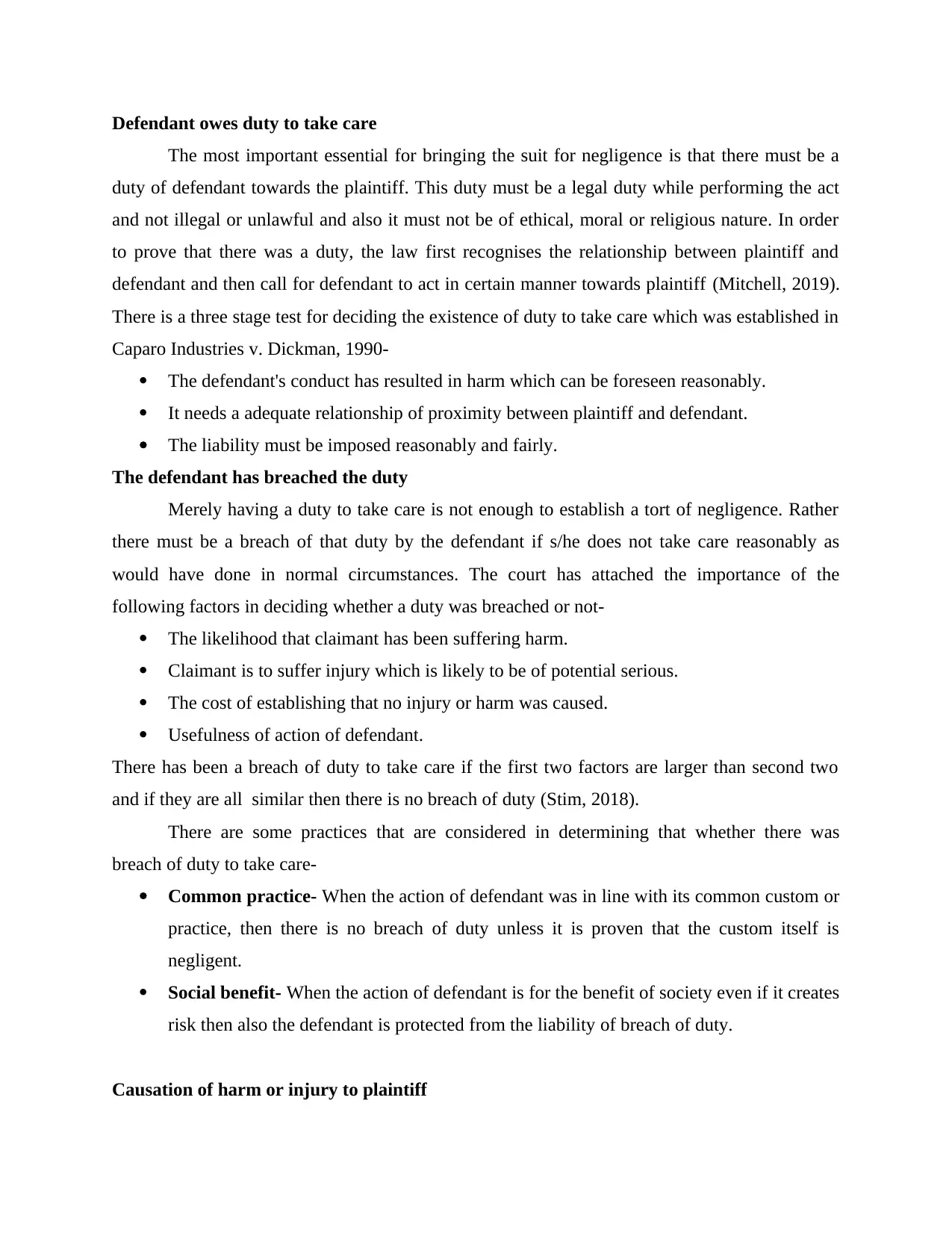
Defendant owes duty to take care
The most important essential for bringing the suit for negligence is that there must be a
duty of defendant towards the plaintiff. This duty must be a legal duty while performing the act
and not illegal or unlawful and also it must not be of ethical, moral or religious nature. In order
to prove that there was a duty, the law first recognises the relationship between plaintiff and
defendant and then call for defendant to act in certain manner towards plaintiff (Mitchell, 2019).
There is a three stage test for deciding the existence of duty to take care which was established in
Caparo Industries v. Dickman, 1990-
The defendant's conduct has resulted in harm which can be foreseen reasonably.
It needs a adequate relationship of proximity between plaintiff and defendant.
The liability must be imposed reasonably and fairly.
The defendant has breached the duty
Merely having a duty to take care is not enough to establish a tort of negligence. Rather
there must be a breach of that duty by the defendant if s/he does not take care reasonably as
would have done in normal circumstances. The court has attached the importance of the
following factors in deciding whether a duty was breached or not-
The likelihood that claimant has been suffering harm.
Claimant is to suffer injury which is likely to be of potential serious.
The cost of establishing that no injury or harm was caused.
Usefulness of action of defendant.
There has been a breach of duty to take care if the first two factors are larger than second two
and if they are all similar then there is no breach of duty (Stim, 2018).
There are some practices that are considered in determining that whether there was
breach of duty to take care-
Common practice- When the action of defendant was in line with its common custom or
practice, then there is no breach of duty unless it is proven that the custom itself is
negligent.
Social benefit- When the action of defendant is for the benefit of society even if it creates
risk then also the defendant is protected from the liability of breach of duty.
Causation of harm or injury to plaintiff
The most important essential for bringing the suit for negligence is that there must be a
duty of defendant towards the plaintiff. This duty must be a legal duty while performing the act
and not illegal or unlawful and also it must not be of ethical, moral or religious nature. In order
to prove that there was a duty, the law first recognises the relationship between plaintiff and
defendant and then call for defendant to act in certain manner towards plaintiff (Mitchell, 2019).
There is a three stage test for deciding the existence of duty to take care which was established in
Caparo Industries v. Dickman, 1990-
The defendant's conduct has resulted in harm which can be foreseen reasonably.
It needs a adequate relationship of proximity between plaintiff and defendant.
The liability must be imposed reasonably and fairly.
The defendant has breached the duty
Merely having a duty to take care is not enough to establish a tort of negligence. Rather
there must be a breach of that duty by the defendant if s/he does not take care reasonably as
would have done in normal circumstances. The court has attached the importance of the
following factors in deciding whether a duty was breached or not-
The likelihood that claimant has been suffering harm.
Claimant is to suffer injury which is likely to be of potential serious.
The cost of establishing that no injury or harm was caused.
Usefulness of action of defendant.
There has been a breach of duty to take care if the first two factors are larger than second two
and if they are all similar then there is no breach of duty (Stim, 2018).
There are some practices that are considered in determining that whether there was
breach of duty to take care-
Common practice- When the action of defendant was in line with its common custom or
practice, then there is no breach of duty unless it is proven that the custom itself is
negligent.
Social benefit- When the action of defendant is for the benefit of society even if it creates
risk then also the defendant is protected from the liability of breach of duty.
Causation of harm or injury to plaintiff
⊘ This is a preview!⊘
Do you want full access?
Subscribe today to unlock all pages.

Trusted by 1+ million students worldwide
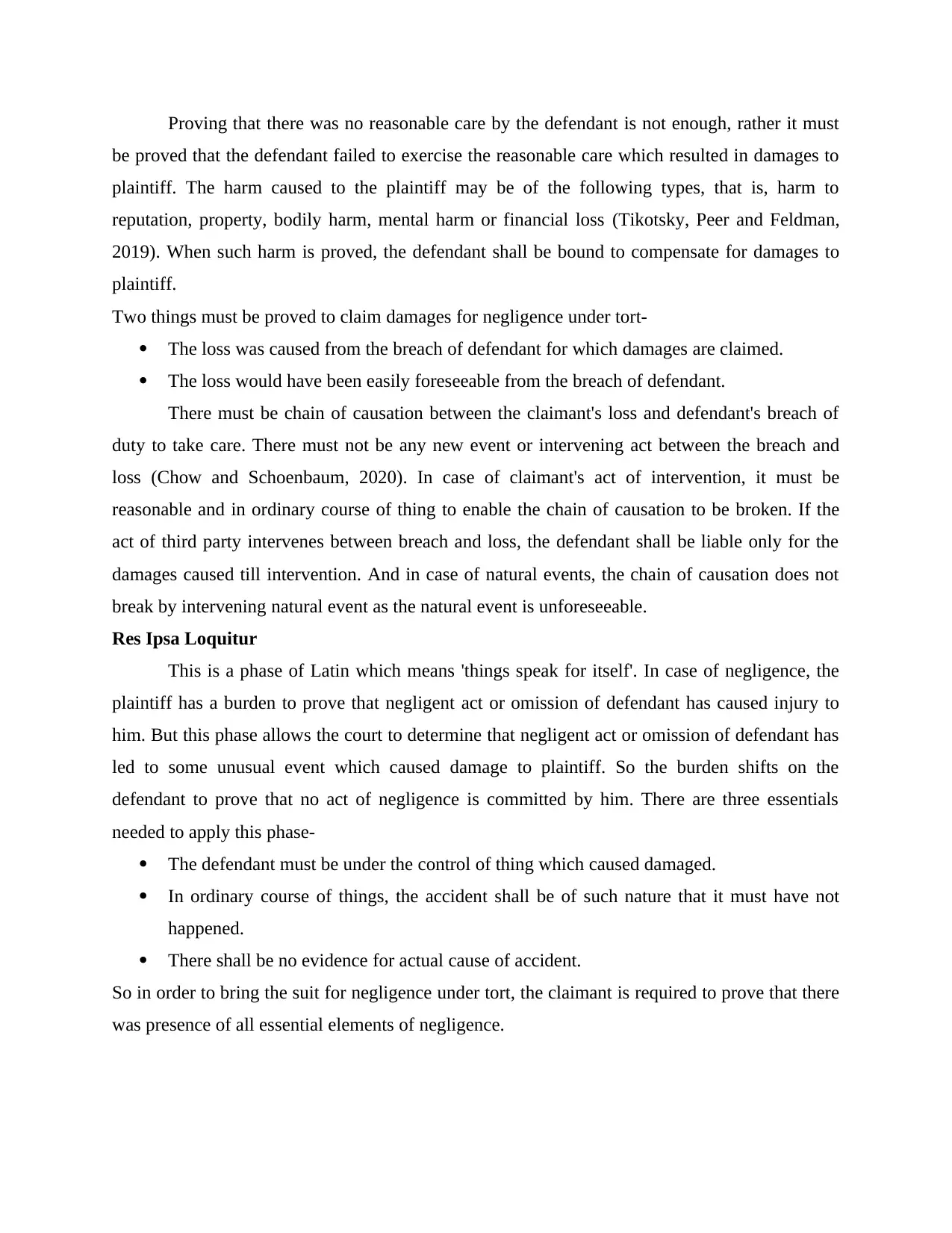
Proving that there was no reasonable care by the defendant is not enough, rather it must
be proved that the defendant failed to exercise the reasonable care which resulted in damages to
plaintiff. The harm caused to the plaintiff may be of the following types, that is, harm to
reputation, property, bodily harm, mental harm or financial loss (Tikotsky, Peer and Feldman,
2019). When such harm is proved, the defendant shall be bound to compensate for damages to
plaintiff.
Two things must be proved to claim damages for negligence under tort-
The loss was caused from the breach of defendant for which damages are claimed.
The loss would have been easily foreseeable from the breach of defendant.
There must be chain of causation between the claimant's loss and defendant's breach of
duty to take care. There must not be any new event or intervening act between the breach and
loss (Chow and Schoenbaum, 2020). In case of claimant's act of intervention, it must be
reasonable and in ordinary course of thing to enable the chain of causation to be broken. If the
act of third party intervenes between breach and loss, the defendant shall be liable only for the
damages caused till intervention. And in case of natural events, the chain of causation does not
break by intervening natural event as the natural event is unforeseeable.
Res Ipsa Loquitur
This is a phase of Latin which means 'things speak for itself'. In case of negligence, the
plaintiff has a burden to prove that negligent act or omission of defendant has caused injury to
him. But this phase allows the court to determine that negligent act or omission of defendant has
led to some unusual event which caused damage to plaintiff. So the burden shifts on the
defendant to prove that no act of negligence is committed by him. There are three essentials
needed to apply this phase-
The defendant must be under the control of thing which caused damaged.
In ordinary course of things, the accident shall be of such nature that it must have not
happened.
There shall be no evidence for actual cause of accident.
So in order to bring the suit for negligence under tort, the claimant is required to prove that there
was presence of all essential elements of negligence.
be proved that the defendant failed to exercise the reasonable care which resulted in damages to
plaintiff. The harm caused to the plaintiff may be of the following types, that is, harm to
reputation, property, bodily harm, mental harm or financial loss (Tikotsky, Peer and Feldman,
2019). When such harm is proved, the defendant shall be bound to compensate for damages to
plaintiff.
Two things must be proved to claim damages for negligence under tort-
The loss was caused from the breach of defendant for which damages are claimed.
The loss would have been easily foreseeable from the breach of defendant.
There must be chain of causation between the claimant's loss and defendant's breach of
duty to take care. There must not be any new event or intervening act between the breach and
loss (Chow and Schoenbaum, 2020). In case of claimant's act of intervention, it must be
reasonable and in ordinary course of thing to enable the chain of causation to be broken. If the
act of third party intervenes between breach and loss, the defendant shall be liable only for the
damages caused till intervention. And in case of natural events, the chain of causation does not
break by intervening natural event as the natural event is unforeseeable.
Res Ipsa Loquitur
This is a phase of Latin which means 'things speak for itself'. In case of negligence, the
plaintiff has a burden to prove that negligent act or omission of defendant has caused injury to
him. But this phase allows the court to determine that negligent act or omission of defendant has
led to some unusual event which caused damage to plaintiff. So the burden shifts on the
defendant to prove that no act of negligence is committed by him. There are three essentials
needed to apply this phase-
The defendant must be under the control of thing which caused damaged.
In ordinary course of things, the accident shall be of such nature that it must have not
happened.
There shall be no evidence for actual cause of accident.
So in order to bring the suit for negligence under tort, the claimant is required to prove that there
was presence of all essential elements of negligence.
Paraphrase This Document
Need a fresh take? Get an instant paraphrase of this document with our AI Paraphraser
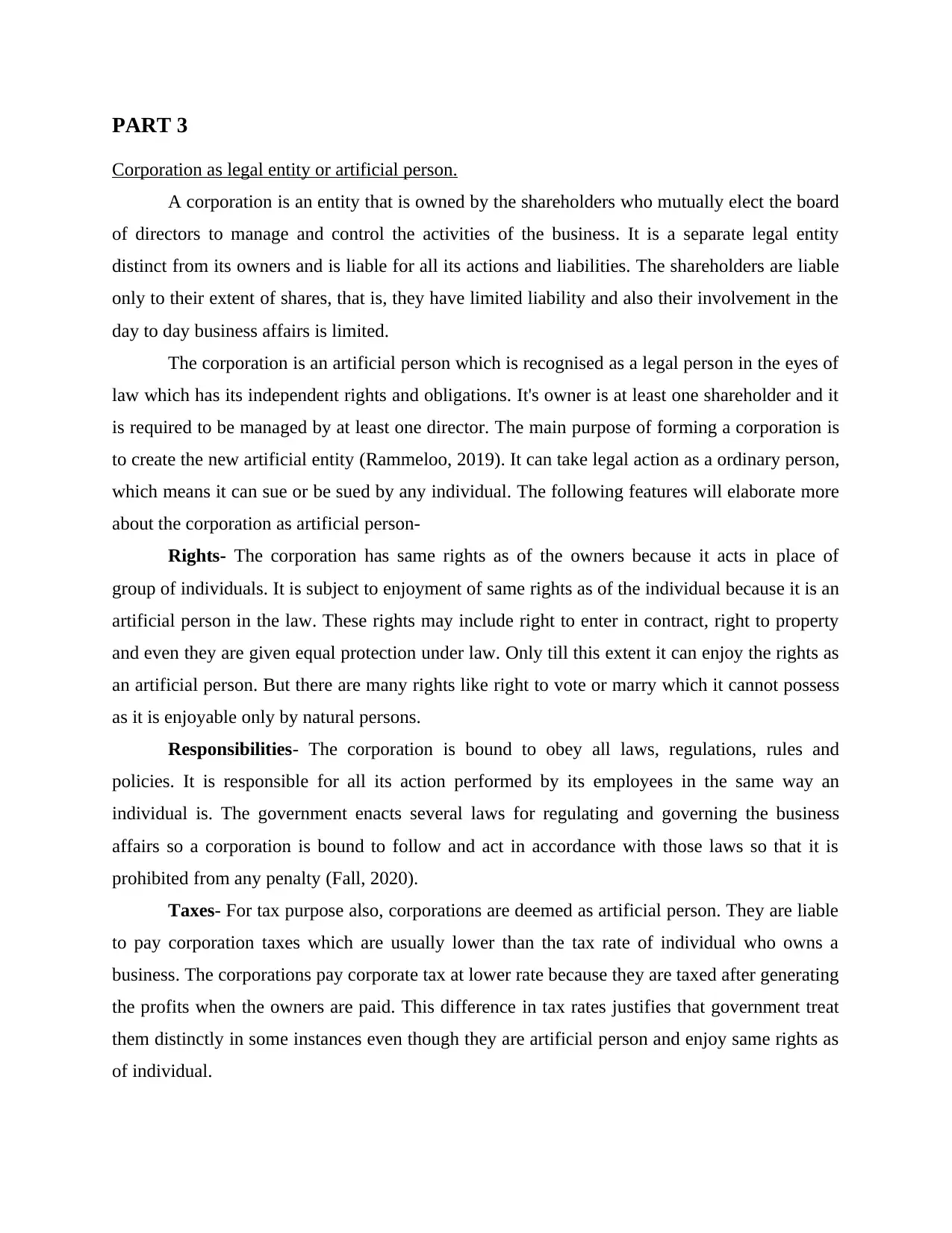
PART 3
Corporation as legal entity or artificial person.
A corporation is an entity that is owned by the shareholders who mutually elect the board
of directors to manage and control the activities of the business. It is a separate legal entity
distinct from its owners and is liable for all its actions and liabilities. The shareholders are liable
only to their extent of shares, that is, they have limited liability and also their involvement in the
day to day business affairs is limited.
The corporation is an artificial person which is recognised as a legal person in the eyes of
law which has its independent rights and obligations. It's owner is at least one shareholder and it
is required to be managed by at least one director. The main purpose of forming a corporation is
to create the new artificial entity (Rammeloo, 2019). It can take legal action as a ordinary person,
which means it can sue or be sued by any individual. The following features will elaborate more
about the corporation as artificial person-
Rights- The corporation has same rights as of the owners because it acts in place of
group of individuals. It is subject to enjoyment of same rights as of the individual because it is an
artificial person in the law. These rights may include right to enter in contract, right to property
and even they are given equal protection under law. Only till this extent it can enjoy the rights as
an artificial person. But there are many rights like right to vote or marry which it cannot possess
as it is enjoyable only by natural persons.
Responsibilities- The corporation is bound to obey all laws, regulations, rules and
policies. It is responsible for all its action performed by its employees in the same way an
individual is. The government enacts several laws for regulating and governing the business
affairs so a corporation is bound to follow and act in accordance with those laws so that it is
prohibited from any penalty (Fall, 2020).
Taxes- For tax purpose also, corporations are deemed as artificial person. They are liable
to pay corporation taxes which are usually lower than the tax rate of individual who owns a
business. The corporations pay corporate tax at lower rate because they are taxed after generating
the profits when the owners are paid. This difference in tax rates justifies that government treat
them distinctly in some instances even though they are artificial person and enjoy same rights as
of individual.
Corporation as legal entity or artificial person.
A corporation is an entity that is owned by the shareholders who mutually elect the board
of directors to manage and control the activities of the business. It is a separate legal entity
distinct from its owners and is liable for all its actions and liabilities. The shareholders are liable
only to their extent of shares, that is, they have limited liability and also their involvement in the
day to day business affairs is limited.
The corporation is an artificial person which is recognised as a legal person in the eyes of
law which has its independent rights and obligations. It's owner is at least one shareholder and it
is required to be managed by at least one director. The main purpose of forming a corporation is
to create the new artificial entity (Rammeloo, 2019). It can take legal action as a ordinary person,
which means it can sue or be sued by any individual. The following features will elaborate more
about the corporation as artificial person-
Rights- The corporation has same rights as of the owners because it acts in place of
group of individuals. It is subject to enjoyment of same rights as of the individual because it is an
artificial person in the law. These rights may include right to enter in contract, right to property
and even they are given equal protection under law. Only till this extent it can enjoy the rights as
an artificial person. But there are many rights like right to vote or marry which it cannot possess
as it is enjoyable only by natural persons.
Responsibilities- The corporation is bound to obey all laws, regulations, rules and
policies. It is responsible for all its action performed by its employees in the same way an
individual is. The government enacts several laws for regulating and governing the business
affairs so a corporation is bound to follow and act in accordance with those laws so that it is
prohibited from any penalty (Fall, 2020).
Taxes- For tax purpose also, corporations are deemed as artificial person. They are liable
to pay corporation taxes which are usually lower than the tax rate of individual who owns a
business. The corporations pay corporate tax at lower rate because they are taxed after generating
the profits when the owners are paid. This difference in tax rates justifies that government treat
them distinctly in some instances even though they are artificial person and enjoy same rights as
of individual.
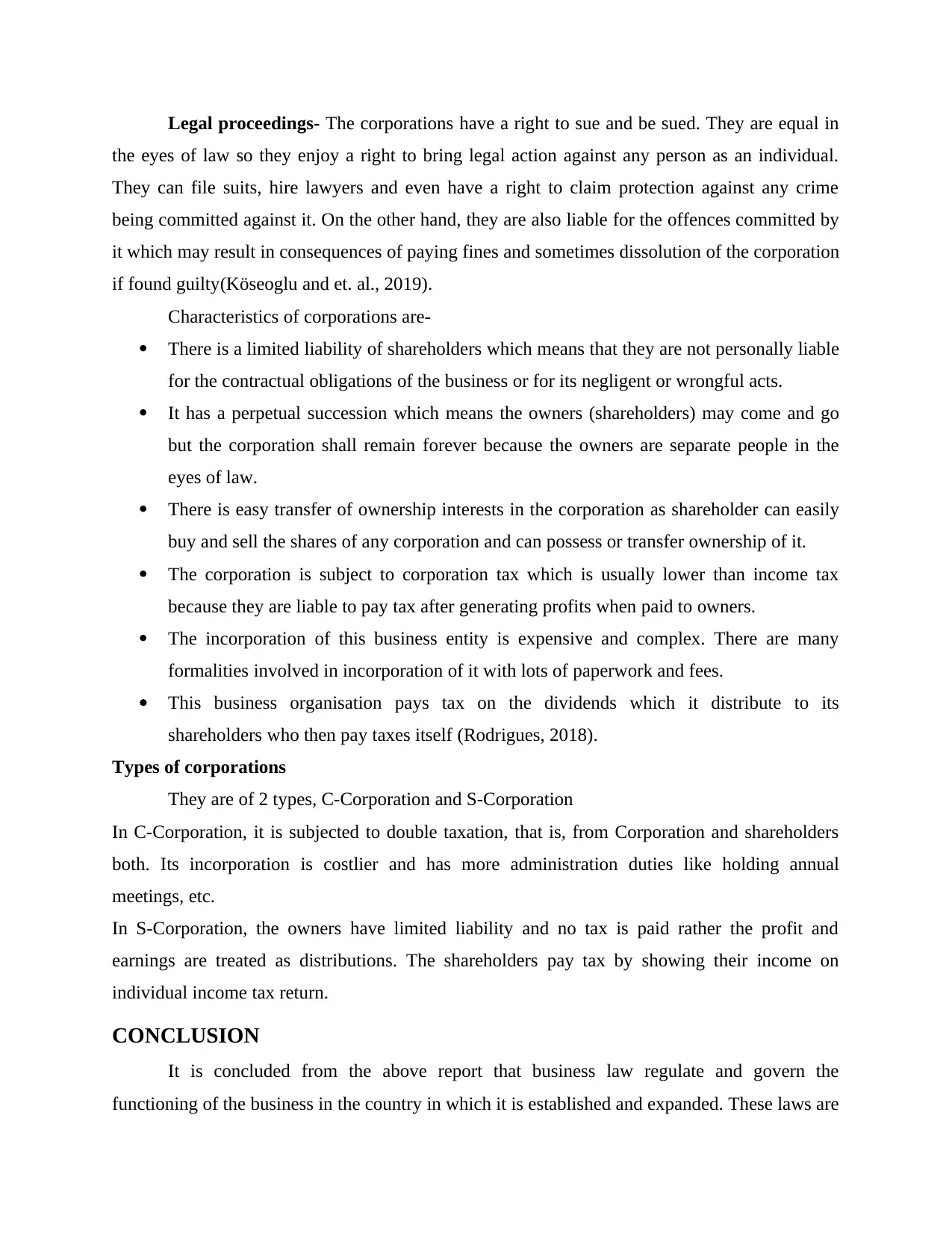
Legal proceedings- The corporations have a right to sue and be sued. They are equal in
the eyes of law so they enjoy a right to bring legal action against any person as an individual.
They can file suits, hire lawyers and even have a right to claim protection against any crime
being committed against it. On the other hand, they are also liable for the offences committed by
it which may result in consequences of paying fines and sometimes dissolution of the corporation
if found guilty(Köseoglu and et. al., 2019).
Characteristics of corporations are-
There is a limited liability of shareholders which means that they are not personally liable
for the contractual obligations of the business or for its negligent or wrongful acts.
It has a perpetual succession which means the owners (shareholders) may come and go
but the corporation shall remain forever because the owners are separate people in the
eyes of law.
There is easy transfer of ownership interests in the corporation as shareholder can easily
buy and sell the shares of any corporation and can possess or transfer ownership of it.
The corporation is subject to corporation tax which is usually lower than income tax
because they are liable to pay tax after generating profits when paid to owners.
The incorporation of this business entity is expensive and complex. There are many
formalities involved in incorporation of it with lots of paperwork and fees.
This business organisation pays tax on the dividends which it distribute to its
shareholders who then pay taxes itself (Rodrigues, 2018).
Types of corporations
They are of 2 types, C-Corporation and S-Corporation
In C-Corporation, it is subjected to double taxation, that is, from Corporation and shareholders
both. Its incorporation is costlier and has more administration duties like holding annual
meetings, etc.
In S-Corporation, the owners have limited liability and no tax is paid rather the profit and
earnings are treated as distributions. The shareholders pay tax by showing their income on
individual income tax return.
CONCLUSION
It is concluded from the above report that business law regulate and govern the
functioning of the business in the country in which it is established and expanded. These laws are
the eyes of law so they enjoy a right to bring legal action against any person as an individual.
They can file suits, hire lawyers and even have a right to claim protection against any crime
being committed against it. On the other hand, they are also liable for the offences committed by
it which may result in consequences of paying fines and sometimes dissolution of the corporation
if found guilty(Köseoglu and et. al., 2019).
Characteristics of corporations are-
There is a limited liability of shareholders which means that they are not personally liable
for the contractual obligations of the business or for its negligent or wrongful acts.
It has a perpetual succession which means the owners (shareholders) may come and go
but the corporation shall remain forever because the owners are separate people in the
eyes of law.
There is easy transfer of ownership interests in the corporation as shareholder can easily
buy and sell the shares of any corporation and can possess or transfer ownership of it.
The corporation is subject to corporation tax which is usually lower than income tax
because they are liable to pay tax after generating profits when paid to owners.
The incorporation of this business entity is expensive and complex. There are many
formalities involved in incorporation of it with lots of paperwork and fees.
This business organisation pays tax on the dividends which it distribute to its
shareholders who then pay taxes itself (Rodrigues, 2018).
Types of corporations
They are of 2 types, C-Corporation and S-Corporation
In C-Corporation, it is subjected to double taxation, that is, from Corporation and shareholders
both. Its incorporation is costlier and has more administration duties like holding annual
meetings, etc.
In S-Corporation, the owners have limited liability and no tax is paid rather the profit and
earnings are treated as distributions. The shareholders pay tax by showing their income on
individual income tax return.
CONCLUSION
It is concluded from the above report that business law regulate and govern the
functioning of the business in the country in which it is established and expanded. These laws are
⊘ This is a preview!⊘
Do you want full access?
Subscribe today to unlock all pages.

Trusted by 1+ million students worldwide
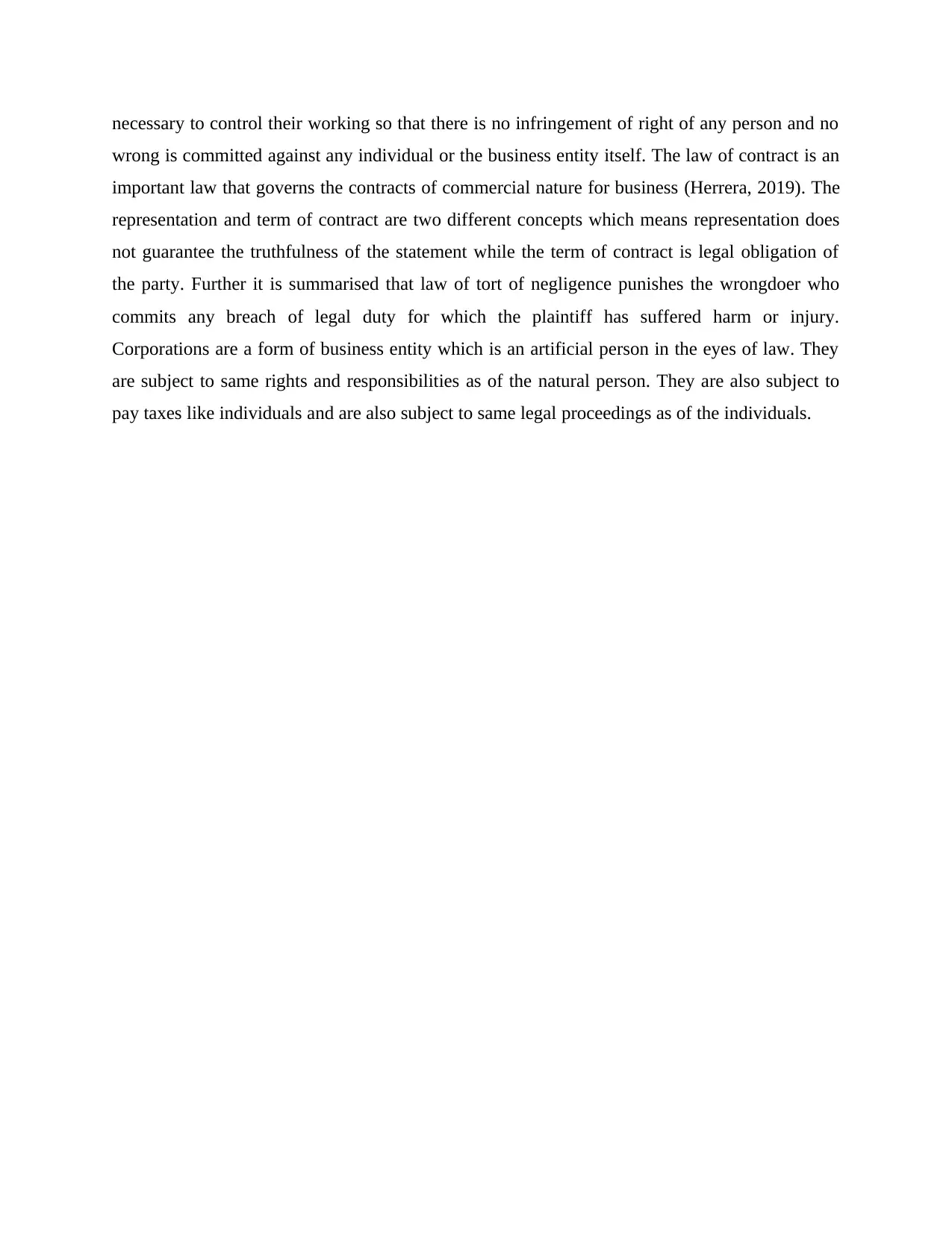
necessary to control their working so that there is no infringement of right of any person and no
wrong is committed against any individual or the business entity itself. The law of contract is an
important law that governs the contracts of commercial nature for business (Herrera, 2019). The
representation and term of contract are two different concepts which means representation does
not guarantee the truthfulness of the statement while the term of contract is legal obligation of
the party. Further it is summarised that law of tort of negligence punishes the wrongdoer who
commits any breach of legal duty for which the plaintiff has suffered harm or injury.
Corporations are a form of business entity which is an artificial person in the eyes of law. They
are subject to same rights and responsibilities as of the natural person. They are also subject to
pay taxes like individuals and are also subject to same legal proceedings as of the individuals.
wrong is committed against any individual or the business entity itself. The law of contract is an
important law that governs the contracts of commercial nature for business (Herrera, 2019). The
representation and term of contract are two different concepts which means representation does
not guarantee the truthfulness of the statement while the term of contract is legal obligation of
the party. Further it is summarised that law of tort of negligence punishes the wrongdoer who
commits any breach of legal duty for which the plaintiff has suffered harm or injury.
Corporations are a form of business entity which is an artificial person in the eyes of law. They
are subject to same rights and responsibilities as of the natural person. They are also subject to
pay taxes like individuals and are also subject to same legal proceedings as of the individuals.
Paraphrase This Document
Need a fresh take? Get an instant paraphrase of this document with our AI Paraphraser
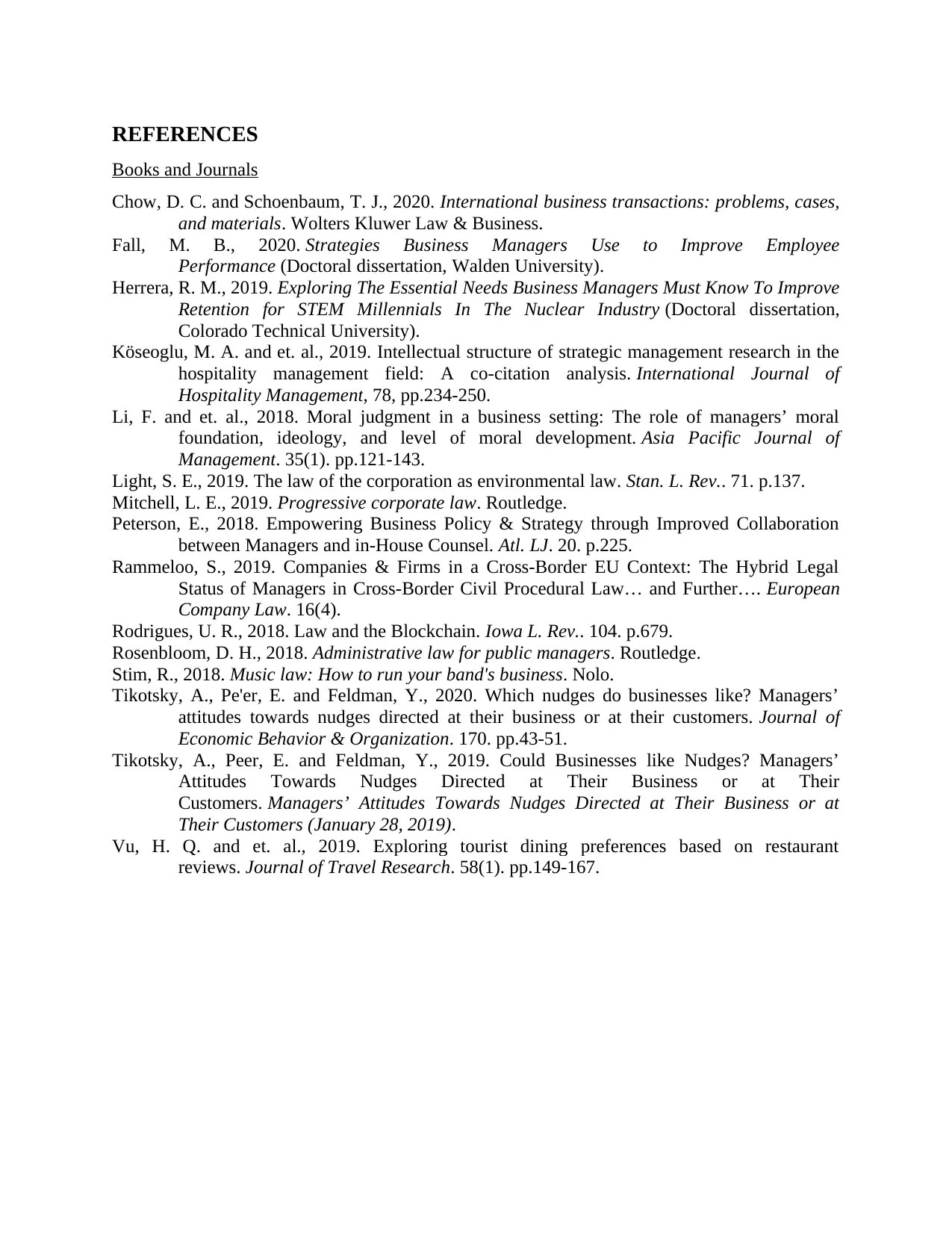
REFERENCES
Books and Journals
Chow, D. C. and Schoenbaum, T. J., 2020. International business transactions: problems, cases,
and materials. Wolters Kluwer Law & Business.
Fall, M. B., 2020. Strategies Business Managers Use to Improve Employee
Performance (Doctoral dissertation, Walden University).
Herrera, R. M., 2019. Exploring The Essential Needs Business Managers Must Know To Improve
Retention for STEM Millennials In The Nuclear Industry (Doctoral dissertation,
Colorado Technical University).
Köseoglu, M. A. and et. al., 2019. Intellectual structure of strategic management research in the
hospitality management field: A co-citation analysis. International Journal of
Hospitality Management, 78, pp.234-250.
Li, F. and et. al., 2018. Moral judgment in a business setting: The role of managers’ moral
foundation, ideology, and level of moral development. Asia Pacific Journal of
Management. 35(1). pp.121-143.
Light, S. E., 2019. The law of the corporation as environmental law. Stan. L. Rev.. 71. p.137.
Mitchell, L. E., 2019. Progressive corporate law. Routledge.
Peterson, E., 2018. Empowering Business Policy & Strategy through Improved Collaboration
between Managers and in-House Counsel. Atl. LJ. 20. p.225.
Rammeloo, S., 2019. Companies & Firms in a Cross-Border EU Context: The Hybrid Legal
Status of Managers in Cross-Border Civil Procedural Law… and Further…. European
Company Law. 16(4).
Rodrigues, U. R., 2018. Law and the Blockchain. Iowa L. Rev.. 104. p.679.
Rosenbloom, D. H., 2018. Administrative law for public managers. Routledge.
Stim, R., 2018. Music law: How to run your band's business. Nolo.
Tikotsky, A., Pe'er, E. and Feldman, Y., 2020. Which nudges do businesses like? Managers’
attitudes towards nudges directed at their business or at their customers. Journal of
Economic Behavior & Organization. 170. pp.43-51.
Tikotsky, A., Peer, E. and Feldman, Y., 2019. Could Businesses like Nudges? Managers’
Attitudes Towards Nudges Directed at Their Business or at Their
Customers. Managers’ Attitudes Towards Nudges Directed at Their Business or at
Their Customers (January 28, 2019).
Vu, H. Q. and et. al., 2019. Exploring tourist dining preferences based on restaurant
reviews. Journal of Travel Research. 58(1). pp.149-167.
Books and Journals
Chow, D. C. and Schoenbaum, T. J., 2020. International business transactions: problems, cases,
and materials. Wolters Kluwer Law & Business.
Fall, M. B., 2020. Strategies Business Managers Use to Improve Employee
Performance (Doctoral dissertation, Walden University).
Herrera, R. M., 2019. Exploring The Essential Needs Business Managers Must Know To Improve
Retention for STEM Millennials In The Nuclear Industry (Doctoral dissertation,
Colorado Technical University).
Köseoglu, M. A. and et. al., 2019. Intellectual structure of strategic management research in the
hospitality management field: A co-citation analysis. International Journal of
Hospitality Management, 78, pp.234-250.
Li, F. and et. al., 2018. Moral judgment in a business setting: The role of managers’ moral
foundation, ideology, and level of moral development. Asia Pacific Journal of
Management. 35(1). pp.121-143.
Light, S. E., 2019. The law of the corporation as environmental law. Stan. L. Rev.. 71. p.137.
Mitchell, L. E., 2019. Progressive corporate law. Routledge.
Peterson, E., 2018. Empowering Business Policy & Strategy through Improved Collaboration
between Managers and in-House Counsel. Atl. LJ. 20. p.225.
Rammeloo, S., 2019. Companies & Firms in a Cross-Border EU Context: The Hybrid Legal
Status of Managers in Cross-Border Civil Procedural Law… and Further…. European
Company Law. 16(4).
Rodrigues, U. R., 2018. Law and the Blockchain. Iowa L. Rev.. 104. p.679.
Rosenbloom, D. H., 2018. Administrative law for public managers. Routledge.
Stim, R., 2018. Music law: How to run your band's business. Nolo.
Tikotsky, A., Pe'er, E. and Feldman, Y., 2020. Which nudges do businesses like? Managers’
attitudes towards nudges directed at their business or at their customers. Journal of
Economic Behavior & Organization. 170. pp.43-51.
Tikotsky, A., Peer, E. and Feldman, Y., 2019. Could Businesses like Nudges? Managers’
Attitudes Towards Nudges Directed at Their Business or at Their
Customers. Managers’ Attitudes Towards Nudges Directed at Their Business or at
Their Customers (January 28, 2019).
Vu, H. Q. and et. al., 2019. Exploring tourist dining preferences based on restaurant
reviews. Journal of Travel Research. 58(1). pp.149-167.
1 out of 11
Related Documents
Your All-in-One AI-Powered Toolkit for Academic Success.
+13062052269
info@desklib.com
Available 24*7 on WhatsApp / Email
![[object Object]](/_next/static/media/star-bottom.7253800d.svg)
Unlock your academic potential
Copyright © 2020–2025 A2Z Services. All Rights Reserved. Developed and managed by ZUCOL.





